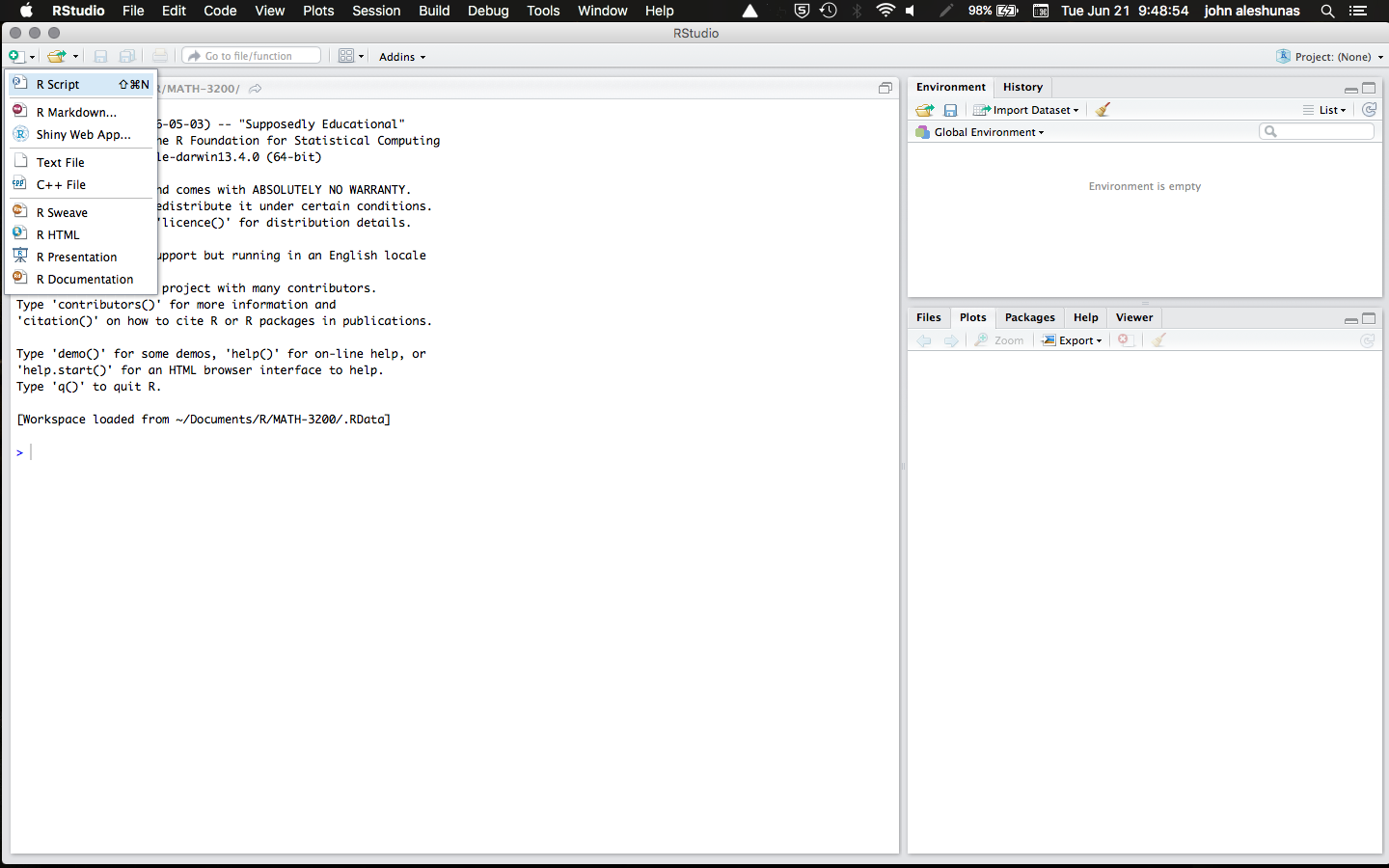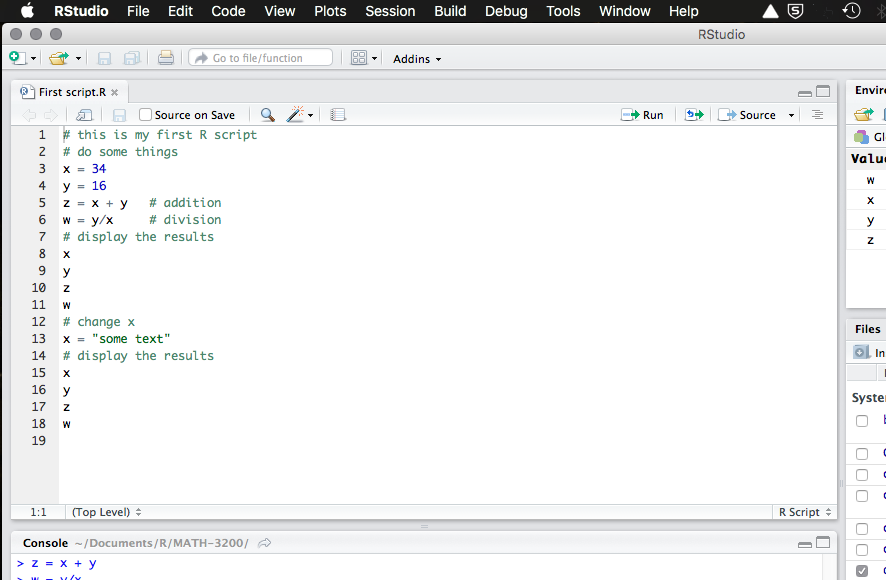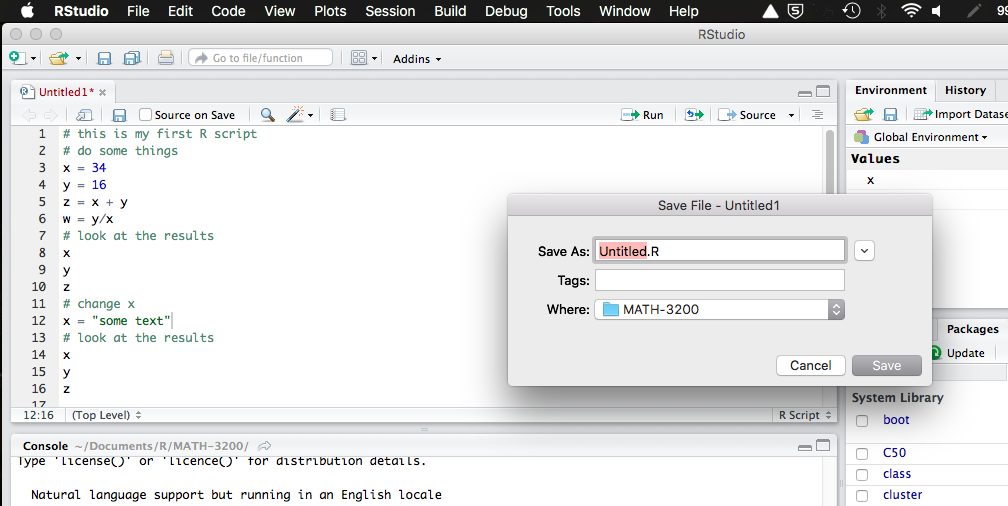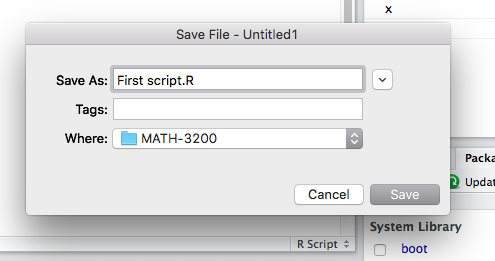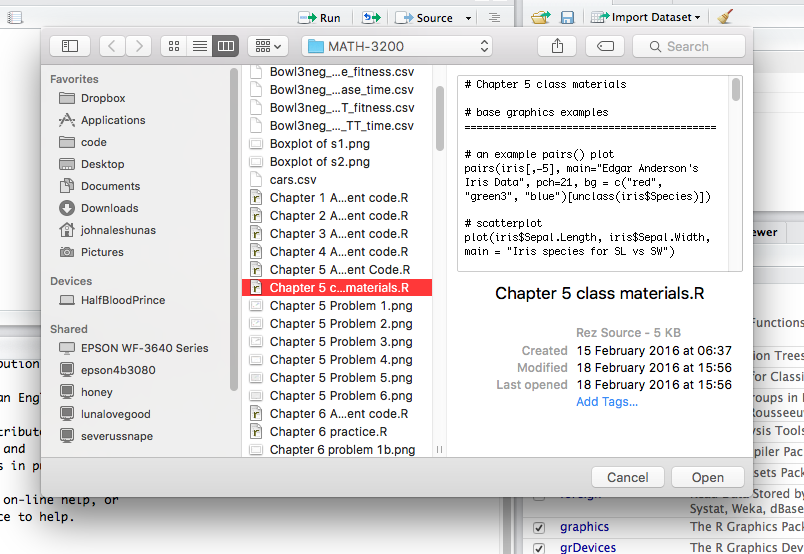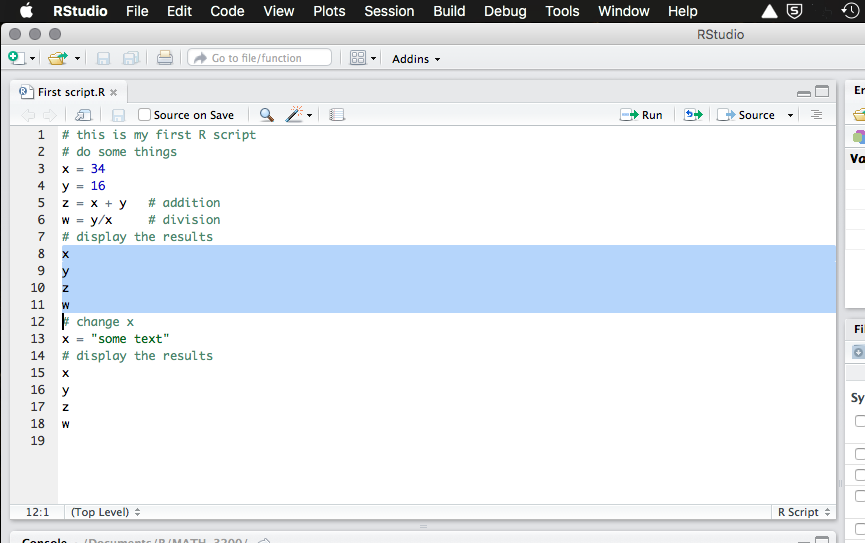R
scripts
While entering and running your code at the R command line is effective
and simple. This technique has its limitations. Each time you want to
execute a set of commands, you have to re-enter them at the command
line. Complex commands are potentially subject to typographical errors,
necessitating that they be re-entered correctly. Repeating a set of
operations requires re-entering the code stream. Fortunately, R and
RStudio provide a method to mitigate these issues. R scripts are that
solution.
A
script is simply a text file containing a set of commands and comments.
The script can be saved and used later to re-execute the saved commands.
The script can also be edited so you can execute a modified version of
the commands.
Creating
an R script
It
is easy to create a new script in RStudio. You can open a new empty
script by clicking the New File icon in the upper left
of the main RStudio toolbar. This icon looks like a white square with a
white plus sign in a green circle. Clicking the icon opens the New
File Menu. Click the R Script menu option
and the script editor will open with an empty script.
Figure
1 - RStudio New Script Menu
Once
the new script opens in the Script Editor panel, the script is ready for
text entry, and your RStudio session will look like this.
Figure
2 - RStudio with Script Editor Panel
Here
is an easy example to familiarize you with the Script Editor interface.
Type the following code into your new script [later topics will explain
the specific code components do].
#
this is my first R script
# do some things
x = 34
y = 16
z = x + y #
addition
w =
y/x # division
# display the results
x
y
z
w
# change x
x = "some text"
# display the results
x
y
z
w
Figure
3 - R Script Example
There,
you now have your first R script. Notice how the editor places a number
in front of each line of code. The line numbers can be helpful as you
work with your code. Before proceeding on to executing this code, it
would be a good idea to learn how to save your script.
Saving
an R script
You
can save your script by clicking on the Save icon at
the top of the Script Editor panel. When you do that,
a Save File dialog will open.
Figure
4 - Save File Dialog
The
default script name is Untitled.R. The Untitled part
is highlighted. You will save this script as First script.R.
Start typing First script. RStudio overwrites the
highlighted default name with your new name, leaving the .R file
extension. The Save File dialog should now look like this.
Figure
5 - Save First script.R
Notice
that RStudio will save your script to your current working folder. An
earlier topic in this learning infrastructure explained how to set your
default working folder, so that will not be addressed here. Press the Save
button and your script is saved to your working folder.
Notice that the name in the file tab at the top of the Script Editor
panel now shows your saved script file name.
Be
aware that, while it is not necessary to use an .R
file extension for your R scripts, it does make it easier for RStudio to
work with them if your use this file extension.
That
is how you save your script files to your working folder.
Opening
an R script
Opening
a saved R script is easy to do. Click on the Open an existing
file icon in the RStudio toolbar. A Choose file dialog will
open.
Figure
6 - RStudio Open Script Dialog
Select
the R script you want to open [this is one place where the .R file
extension comes in handy] and click the Open button.
Your script will open in the Script Editor panel with the script name in
an editor tab.
Working
through an example may be helpful. We will use the script you created
above [First script.R] for this exercise. First, you
will need to close the script. You can close this script by clicking the
X in the right side of the editor tab where the script
name appears. Since you only had one script open, when you close First
script.R, the Script Editor panel disappears.
Now,
click on the Open an existing file icon in the RStudio
toolbar. The Choose file dialog will open. Select First
script.R and then press the Open button in
the dialog. Your script is now open in the Script Editor panel and ready
to use.
Executing
code in an R script
You
can run the code in your R script easily. The Run button
in the Script Editor panel toolbar will run either the current line of
code or any block of selected code. You can use your First
script.R code to gain familiarity with this functionality.
Place
the cursor anywhere in line 3 of your script [x = 34]. Now press the Run
button in the Script Editor panel toolbar. Three things
happen: 1) the code is transferred to the command console, 2) the code
is executed, and 3) the cursor moves to the next line in your script.
Press the Run button three more times. RStudio
executes lines 4, 5, and 6 of your script.
Now
you will run a set of code commands all at once. Highlight lines 8, 9,
10, and 11 in the script.
Figure
7 - Highlighted Script Code
Highlighting
is accomplished similar to what you may be familiar with in word
processor applications. You click your left mouse button and the
beginning of the text you want to highlight, you hold the mouse button
and drag the cursor to the end of the text and release the button. With
those four lines of code highlighted, click the editor Run
button. All four lines of code are executed in the command console. That
is all it takes to run script code in RStudio.
Comments
in an R script [documenting your code]
Before
finishing this topic, there is one final concept you should understand.
It is always a good idea to place comments in your code. They will help
you understand what your code is meant to do. This will become helpful
when you reopen code you wrote weeks ago and are trying to work with
again. The saying, "Real programmers do not document their code. If it
was hard to write, it should be hard to understand" is meant to be a
dark joke, not a coding style guide.
Figure
8 - R Script Example [with comments]
A
comment in R code begins with the # symbol. Your code
in First script.R contains several examples of
comments. Lines 1, 2, 7, 12, and 14 in the image above are all comment
lines. Any line of text that starts with # will be
treated as a comment and will be ignored during code execution. Lines 5
and 6 in this image contain comments at the end. All text after the #
is treated as a comment and is ignored during execution.
Notice
how the RStudio editor shows these comments colored green. The green
color helps you focus on the code and not get confused by the
comments.
Besides
using comments to help make your R code more easily understood, you can
use the # symbol to ignore lines of code while you
are developing your code stream. Simply place a # in
front of any line that you want to ignore. R will treat those lines as
comments and ignore them. When you want to include those lines again in
the code execution, remove the # symbols and the code
is executable again. This technique allows you to change what code you
execute without having to retype deleted code.
